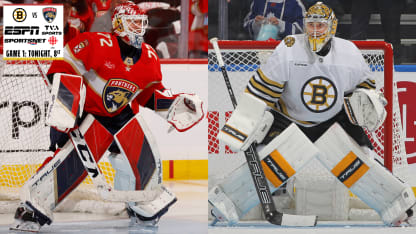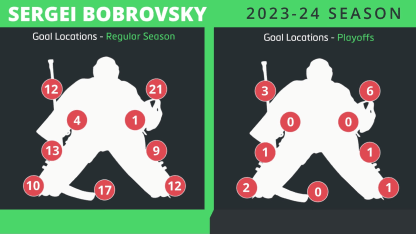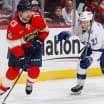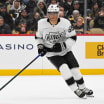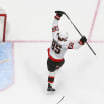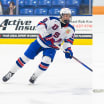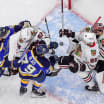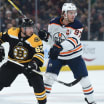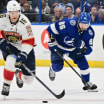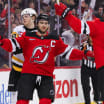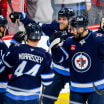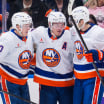Stretch things wide: Bobrovsky has one of the NHL’s most powerful cross-ice pushes and an impressive ability to extend into splits-type saves without losing access to active hands, so just making plays from one side to the other across the slot line, which divides the middle of the ice from the goal line to top of the circles, isn’t always enough. These types of lateral plays, which increase the chances of scoring on any goalie, accounted for 23 percent of regular-season goals and four of 14 in the first round, but Bobrovsky typically performs well against them, especially higher in the zone. Trying to work side-to-side down low or stretch him out with tip options wide of the net, especially when he’s at the edge of the crease, makes it harder to rotate into those lateral pushes, potentially opening gaps on second chances even if he gets to the first.
Five-hole: Nothing went between Bobrovsky’s pads in the first round, but the 17 tracked regular-season goals that went in five-hole jumps off the chart and is well above the tracked average for over 7,000 goals since this project started back in 2017. Scramble plays and rebounds accounted for 10 of the 17, making quick low shots back into the middle of his coverage an option worth trying even for a goalie whose lateral power makes it so important to raise the puck into the upper half of the net on the above-mentioned lateral chances. There were also three 5-hole goals on screens, proof the high stance Bobrovsky uses to see over traffic can be vulnerable to low shots, and another three on breakaways as shooters took advantage of the patience on his edges that is otherwise considered a strength with quick, low shots.
Screens: “Get more traffic” is a cliché this time of the season for a reason. Bobrovsky managed screens at a slightly above-average rate in the regular season with 15 goals allowed, but they were a main factor on 5 of 14 in the first round. If you can’t catch him in that elevated stance that leave the five-hole open, shooters higher in the zone can wait for him to transition into his lower, wider save stance before trying to filter high shots to the net.
High glove, not blocker: There was a lot of focus on the blocker last playoffs after the Bruins scored 37.5 percent of their goals shooting mid-to-high blocker side, but the numbers say it’s long been a strength. The way Bobrovsky shapes and holds his stick to prioritize blocker coverage, and a willingness to drop that stick on purpose a times to make active blocker saves, make the blocker side an apparent strength. Shots just off his hip may be a better option on that side, or just avoid it altogether by targeting glove side high on open looks.
One-time and against the grain: As fast as Bobrovsky is, catching him moving is key, with quick shots a factor on 35 percent of the regular-season goals and 4 of 14 in the first round, and shots against the grain were a factor in 25 percent in the regular season and four of 14 in the playoffs.
Beware active stick: Bobrovsky does a great job cutting off lateral passes through or near his crease with an active stick throughout the playoffs, so elevating passing attempts through the blue ice might help get a few more to their intended target.
